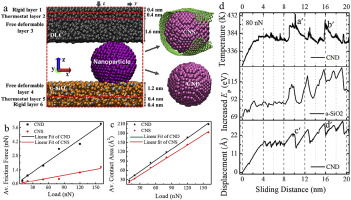当前位置:
X-MOL 学术
›
Tribol. Int.
›
论文详情
Our official English website, www.x-mol.net, welcomes your feedback! (Note: you will need to create a separate account there.)
Friction properties of carbon nanoparticles (nanodiamond and nanoscroll) confined between DLC and α-SiO2 surfaces
Tribology International ( IF 6.2 ) Pub Date : 2020-05-01 , DOI: 10.1016/j.triboint.2019.106153 Weili Zhao , Fangli Duan
Tribology International ( IF 6.2 ) Pub Date : 2020-05-01 , DOI: 10.1016/j.triboint.2019.106153 Weili Zhao , Fangli Duan

|
Abstract Friction properties of carbon nanodiamond (CND) and nanoscroll (CNS formed from graphene patch wrapping around nanodiamond) were studied by nonequilibrium molecular dynamic simulation of sliding diamond-like carbon (DLC) over the nanoparticles supported by amorphous silica (a-SiO2) slabs. CNS reduces friction coefficient (COF) by 72% relative to CND and superlubricity (COF ≤ 0.01) is enabled by CNS, which agrees well with experimental observations. Due to the wrapping graphene patch, the DLC-CNS contact area is smaller than the DLC-CND contact area and the CNS motion is repressed. Contrary to the rolling motion of ball bearings at the macroscale, the repressed motion of nanoparticles reduces the system friction dissipation. These make CNS a more effective solid lubricant compared with CND.
中文翻译:

限制在 DLC 和 α-SiO2 表面之间的碳纳米粒子(纳米金刚石和纳米卷)的摩擦特性
摘要 通过在无定形二氧化硅 (a-SiO2) 平板支撑的纳米颗粒上滑动类金刚石碳 (DLC) 的非平衡分子动力学模拟研究了碳纳米金刚石 (CND) 和纳米卷 (由石墨烯贴片包裹纳米金刚石形成的 CNS) 的摩擦性能。 . CNS 相对于 CND 将摩擦系数 (COF) 降低了 72%,并且 CNS 实现了超润滑性 (COF ≤ 0.01),这与实验观察结果非常吻合。由于包裹石墨烯贴片,DLC-CNS 接触面积小于 DLC-CND 接触面积,CNS 运动受到抑制。与宏观尺度上滚珠轴承的滚动运动相反,纳米颗粒的抑制运动减少了系统摩擦耗散。与 CND 相比,这些使 CNS 成为更有效的固体润滑剂。
更新日期:2020-05-01
中文翻译:

限制在 DLC 和 α-SiO2 表面之间的碳纳米粒子(纳米金刚石和纳米卷)的摩擦特性
摘要 通过在无定形二氧化硅 (a-SiO2) 平板支撑的纳米颗粒上滑动类金刚石碳 (DLC) 的非平衡分子动力学模拟研究了碳纳米金刚石 (CND) 和纳米卷 (由石墨烯贴片包裹纳米金刚石形成的 CNS) 的摩擦性能。 . CNS 相对于 CND 将摩擦系数 (COF) 降低了 72%,并且 CNS 实现了超润滑性 (COF ≤ 0.01),这与实验观察结果非常吻合。由于包裹石墨烯贴片,DLC-CNS 接触面积小于 DLC-CND 接触面积,CNS 运动受到抑制。与宏观尺度上滚珠轴承的滚动运动相反,纳米颗粒的抑制运动减少了系统摩擦耗散。与 CND 相比,这些使 CNS 成为更有效的固体润滑剂。



























 京公网安备 11010802027423号
京公网安备 11010802027423号